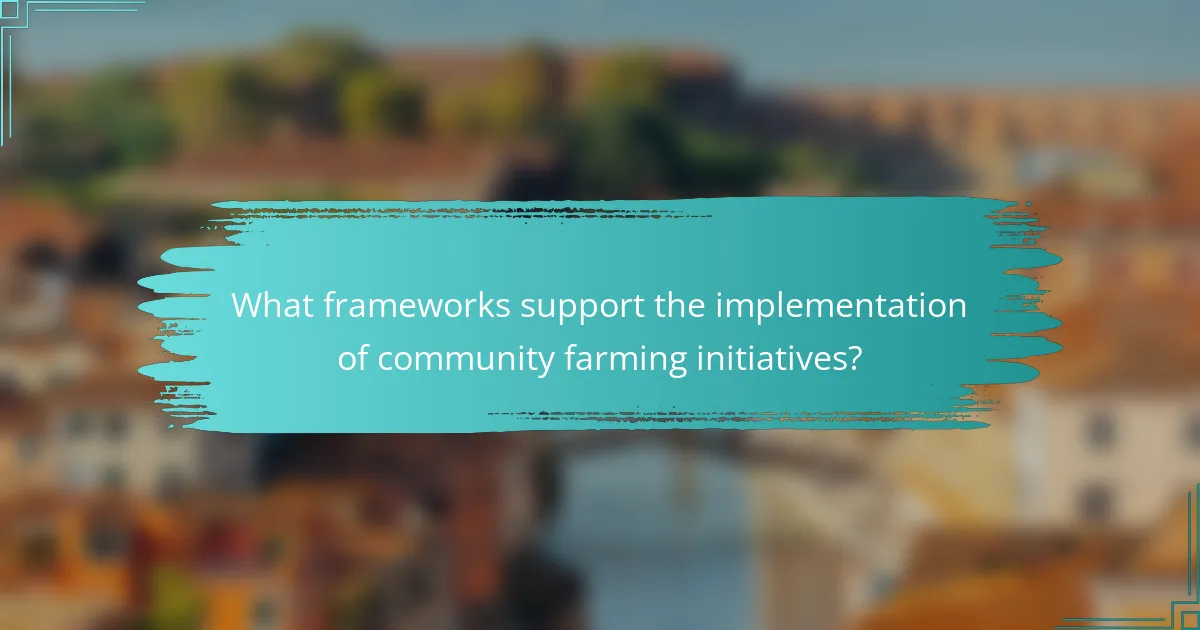Community farming initiatives play a crucial role in assessing and reducing carbon footprints through sustainable agricultural practices. By fostering collaboration among local members, these initiatives aim to enhance soil health, minimize transportation emissions, and utilize renewable energy sources. Additionally, sustainability metrics are employed to evaluate the environmental impact and resource efficiency of these practices, promoting both ecological health and community engagement.

What are community farming initiatives for carbon footprint assessment?
Community farming initiatives for carbon footprint assessment focus on local agricultural practices aimed at reducing greenhouse gas emissions and promoting sustainability. These initiatives often involve collaboration among community members to evaluate and improve their farming methods, ultimately leading to a lower carbon footprint.
Local community gardens
Local community gardens serve as a vital component of urban sustainability efforts. They allow residents to grow their own food, which reduces reliance on transportation and packaging, thereby lowering carbon emissions. These gardens can also enhance biodiversity and improve soil health through organic practices.
To maximize the benefits, community gardens should implement composting and rainwater harvesting systems. Engaging local volunteers can help maintain these gardens while fostering a sense of community and shared responsibility.
Urban agriculture projects
Urban agriculture projects involve growing food in city environments, utilizing vacant lots, rooftops, and other underused spaces. These projects can significantly reduce the carbon footprint associated with food transportation and storage. They often incorporate innovative techniques such as vertical farming and hydroponics to optimize space and resources.
Successful urban agriculture initiatives should focus on community involvement and education. Workshops on sustainable practices can empower residents to participate actively and understand the environmental impact of their food choices.
Cooperative farming models
Cooperative farming models involve groups of farmers working together to share resources, knowledge, and labor. This collaboration can lead to more efficient farming practices and reduced costs, ultimately lowering the carbon footprint of food production. By pooling resources, cooperatives can invest in sustainable technologies and practices that individual farmers might not afford.
To establish a successful cooperative, clear communication and shared goals are essential. Regular meetings and transparent decision-making processes can help maintain cohesion and ensure that all members benefit from the initiative.
Regenerative agriculture practices
Regenerative agriculture practices focus on restoring soil health and enhancing biodiversity while sequestering carbon in the soil. Techniques such as cover cropping, crop rotation, and reduced tillage can improve soil structure and fertility, leading to more resilient farming systems. These practices can significantly mitigate the carbon footprint of agricultural activities.
Farmers interested in regenerative practices should start by assessing their current methods and identifying areas for improvement. Collaborating with local agricultural extension services or sustainability organizations can provide valuable resources and support for transitioning to regenerative techniques.

How do community farming initiatives reduce emissions?
Community farming initiatives reduce emissions primarily through sustainable practices that enhance soil health, minimize transportation, and utilize renewable energy. These methods not only lower carbon footprints but also promote environmental stewardship and community engagement.
Soil carbon sequestration
Soil carbon sequestration involves capturing atmospheric carbon dioxide and storing it in the soil, which can significantly mitigate climate change. Community farms can enhance soil organic matter through practices like cover cropping and reduced tillage, leading to improved soil health and increased carbon storage.
Farmers can adopt techniques such as agroforestry, which integrates trees into farming systems, further boosting carbon sequestration. Regular soil testing can help monitor carbon levels and guide management practices to maximize carbon storage potential.
Reduction of food miles
Reducing food miles refers to minimizing the distance food travels from farm to table, which directly lowers greenhouse gas emissions associated with transportation. Community farms often supply local markets, thereby shortening supply chains and reducing reliance on fossil fuels.
By promoting local consumption, these initiatives can cut food miles significantly, often by several hundred kilometers. Engaging with local restaurants and grocery stores can enhance distribution and encourage community support for local produce.
Use of renewable energy sources
Community farming initiatives can utilize renewable energy sources, such as solar or wind power, to decrease reliance on fossil fuels. Implementing solar panels on farm buildings or using wind turbines can provide clean energy for irrigation, processing, and other farm operations.
Farmers should consider energy audits to identify opportunities for renewable energy integration. Incentives and grants may be available to support the transition to renewable energy, making it a practical choice for community farms.
Waste composting and recycling
Composting organic waste reduces landfill contributions and lowers methane emissions, a potent greenhouse gas. Community farms can implement composting systems to recycle kitchen scraps, yard waste, and agricultural residues into nutrient-rich soil amendments.
Establishing a composting program can be straightforward, involving simple bins or piles. Educating the community on what can be composted helps maximize participation and effectiveness, turning waste into a valuable resource for soil health.

What sustainability metrics are used in community farming?
Sustainability metrics in community farming help assess environmental impact, resource efficiency, and overall ecological health. Key metrics include carbon footprint calculations, water usage efficiency, biodiversity indices, and soil health assessments.
Carbon footprint calculations
Carbon footprint calculations measure the total greenhouse gas emissions produced by community farming activities. This includes emissions from machinery, fertilizers, and transportation of goods. Farmers can use tools like carbon calculators to estimate their emissions and identify areas for reduction.
To effectively reduce carbon footprints, community farms should focus on practices such as using renewable energy sources, optimizing transportation routes, and implementing no-till farming techniques. Regular assessments can help track progress over time.
Water usage efficiency
Water usage efficiency evaluates how effectively community farms utilize water resources for irrigation and crop production. Efficient practices can significantly reduce water waste and improve crop yields. Techniques like drip irrigation and rainwater harvesting are commonly employed.
Farmers should monitor water usage regularly and compare it against crop output to identify inefficiencies. Setting benchmarks based on local climate conditions can help in establishing realistic water usage goals.
Biodiversity indices
Biodiversity indices assess the variety of plant and animal species within a community farm. High biodiversity is crucial for ecosystem resilience and can enhance pest control and pollination. Farmers can promote biodiversity by planting diverse crops and creating habitats for wildlife.
Regular surveys can help track changes in biodiversity over time. Community farms should aim to maintain or increase species diversity, which can lead to healthier ecosystems and improved agricultural sustainability.
Soil health assessments
Soil health assessments evaluate the biological, chemical, and physical properties of soil to determine its fertility and sustainability. Healthy soil supports plant growth, retains moisture, and sequesters carbon. Farmers can conduct soil tests to measure pH, nutrient levels, and microbial activity.
Improving soil health can involve practices like crop rotation, cover cropping, and organic amendments. Regular assessments allow farmers to adjust their practices based on soil conditions, ensuring long-term productivity and environmental health.

What are the benefits of community farming for local economies?
Community farming offers significant advantages for local economies by fostering job creation, supporting local businesses, enhancing food security, and promoting community engagement. These initiatives not only provide fresh produce but also stimulate economic growth and resilience within the community.
Job creation in agriculture
Community farming initiatives can create numerous job opportunities in agriculture, ranging from farm management to seasonal labor. These jobs often cater to diverse skill levels, making them accessible to a wide range of individuals, including youth and those seeking to re-enter the workforce.
In many cases, community farms employ local residents, which helps to circulate money within the community. This localized employment can lead to a reduction in unemployment rates and contribute to overall economic stability.
Support for local businesses
Community farms often collaborate with local businesses, providing them with fresh produce and other agricultural products. This relationship strengthens local supply chains and encourages consumers to buy from nearby vendors, fostering a sense of community and loyalty.
Additionally, community farms can host markets or events that attract visitors, benefiting local restaurants, shops, and service providers. This synergy helps to create a vibrant local economy that supports various sectors.
Increased food security
By producing food locally, community farms enhance food security for residents. They provide access to fresh, nutritious produce, which can be particularly beneficial in areas with limited grocery options. This local sourcing reduces reliance on distant suppliers and mitigates the risks associated with food supply chain disruptions.
Moreover, community farms often implement sustainable practices that contribute to long-term food availability. By focusing on local production, these initiatives can help stabilize food prices and ensure that community members have reliable access to essential resources.
Community engagement and education
Community farming fosters engagement by bringing people together to work towards common goals. This collaboration can strengthen social ties and create a sense of belonging among participants, enhancing community cohesion.
Educational programs offered by community farms can teach residents about sustainable agriculture, nutrition, and environmental stewardship. These initiatives empower individuals with knowledge and skills that can be applied in their own lives, promoting a culture of sustainability and self-sufficiency.

What frameworks support the implementation of community farming initiatives?
Community farming initiatives benefit from various frameworks that facilitate their establishment and sustainability. Key frameworks include government grants and subsidies, partnerships with nonprofit organizations, and community-supported agriculture (CSA) models, each providing essential resources and support for local farming efforts.
Government grants and subsidies
Government grants and subsidies play a crucial role in supporting community farming initiatives by providing financial assistance for start-up costs and operational expenses. These funds can cover equipment purchases, land improvements, and educational programs, making farming more accessible for community members.
In the United States, for example, programs like the USDA’s Community Food Projects Competitive Grant Program offer funding to enhance food security and promote sustainable practices. Farmers should research local, state, and federal programs to identify available financial support tailored to their needs.
Nonprofit organization partnerships
Partnerships with nonprofit organizations can significantly enhance community farming initiatives by providing expertise, resources, and networking opportunities. Nonprofits often focus on sustainability, education, and food justice, aligning their missions with community farming goals.
For instance, organizations like the Land Trust Alliance help secure land access for community farms, while others may offer training programs or volunteer support. Collaborating with nonprofits can amplify the impact of community farming efforts and foster a sense of community engagement.
Community-supported agriculture (CSA) models
Community-supported agriculture (CSA) models create a direct connection between farmers and consumers, allowing community members to invest in local farms upfront. In return, they receive a share of the harvest throughout the growing season, ensuring fresh produce while supporting sustainable practices.
CSAs can vary in structure, with options for weekly or bi-weekly deliveries, and may include vegetables, fruits, and even dairy products. Farmers should consider their production capacity and community preferences when designing a CSA program to ensure its success and sustainability.
